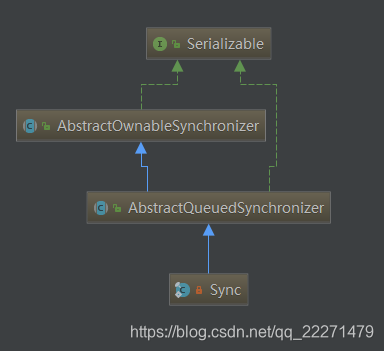CountDownLatch和CyclicBarrier
在看Curator的时候,看到了分布式屏障的设计,所以回头仔细看看Jdk的CyclicBarrier实现思路。这里CountDownLatch和CyclicBarrier的作用有点类似,就一并分析了。
CountDownLatch
- 特点
是一个原子递减操作,当计数器为0的时候,所有等待的线程将释放,阻塞状态将打开。
只能使用一次,count值不能被外界修改。
主要是当当前计数器==0的时候,等待的线程将释放阻塞。可以一个异步执行,比如Zookeeper的连接就可以这么干。
修改count的值可以是一个线程也可以是多个线程
- 类图

实现逻辑
- 初始化CountDownLatch,会有count参数传入,该count参数表示计数器的初始值。
- await方法,当调用await方法时,会去检查是否需要等待,CountDownLatch的Sync类重写了tryAcquireShared方法,该方法在count=0的时候返回1,否则返回-1,所以count必须是一个非负数。
- 当
count>0的情况下,表示该线程需要等待,进入AQS的等待队列。 - 当
count==0的情况下,那么该线程将会直切返回,不会自旋且入队。如果该线程已经是处于等待队列中的时候,那么,将会出队并退出自旋。
- 当
- countDown方法,该方法负责去对count去做–操作,当当前计数器为0的时候,将会直接返回,否则将自旋+CAS进行count–。
源码分析
CountDownLatch.Sync
//这里是await将会调用该方法
protected int tryAcquireShared(int acquires) {
//在count==0的时候直接返回1,否则返回-1,返回-1就表示该线程需要进行自旋入队
return (getState() == 0) ? 1 : -1;
}
//countDown方法将会调用该方法,该方法一定会有返回结果,是一个类同步方法
protected boolean tryReleaseShared(int releases) {
// Decrement count; signal when transition to zero
for (;;) {
int c = getState();
//count==0表示不需要进行--操作,直接返回
if (c == 0)
return false;
//这里通过CAS来进行赋值,加上自旋操作,来保证该方法一定会产生数据变更
int nextc = c-1;
if (compareAndSetState(c, nextc))
//当当前count的值==0的时候返回true将进行doReleaseShared操作,否则不做任何操作
return nextc == 0;
}
}
AbstractQueuedSynchronizer相关源码
//实际做Acquire的方法(当count!=0的时候)
private void doAcquireShared(int arg) {
//入队
final Node node = addWaiter(Node.SHARED);
boolean failed = true;
try {
boolean interrupted = false;
//自旋操作
for (;;) {
//得到上面入队的node的前继
final Node p = node.predecessor();
//当p是队首的话,将会再次count的值
if (p == head) {
//再次判断,这里count==0的时候,r=1
int r = tryAcquireShared(arg);
//当不需要等待的时候,就去释放head
if (r >= 0) {
//这个时候其实需要进行出队操作了,需要将node设置为head节点
setHeadAndPropagate(node, r);
//清理出队的前head
p.next = null; // help GC
if (interrupted)
selfInterrupt();
failed = false;
return;
}
}
//这里是Condition相关的操作
if (shouldParkAfterFailedAcquire(p, node) &&
parkAndCheckInterrupt())
interrupted = true;
}
} finally {
if (failed)
cancelAcquire(node);
}
}
private void setHeadAndPropagate(Node node, int propagate) {
Node h = head;
//将此node设置成head节点
setHead(node);
//propagate 就是 tryAcquireShared的值,当count==0为1
if (propagate > 0 || h == null || h.waitStatus < 0 ||
(h = head) == null || h.waitStatus < 0) {
Node s = node.next;
//如果没有获取节点或者是共享节点
if (s == null || s.isShared())
//释放
doReleaseShared();
}
}
private void doReleaseShared() {
for (;;) {
Node h = head;
if (h != null && h != tail) {
int ws = h.waitStatus;
//独占模式
if (ws == Node.SIGNAL) {
if (!compareAndSetWaitStatus(h, Node.SIGNAL, 0))
continue; // loop to recheck cases
unparkSuccessor(h);
}
//共享模式(ws==0只有第一次进入该方法有效)
else if (ws == 0 &&
!compareAndSetWaitStatus(h, 0, Node.PROPAGATE))
continue; // loop on failed CAS
}
if (h == head) // loop if head changed
break;
}
}
CyclicBarrier
实现逻辑
当所有await的线程数达到初始值时,阻塞的线程将会继续顺序执行。有点像先让线程初一某个屏障,任何线程都不能穿越该屏障,知道线程数达到期望值的时候,那么就会改期屏障,所有线程都会执行。
源码
private int dowait(boolean timed, long nanos)
throws InterruptedException, BrokenBarrierException,
TimeoutException {
//排它锁,因为多个线程来修改count的时候会出现线程不安全的问题,count的共享资源
final ReentrantLock lock = this.lock;
//进入await方法必须先获取锁
lock.lock();
try {
//来标识,是否被中断
final Generation g = generation;
//中断就抛异常
if (g.broken)
throw new BrokenBarrierException();
//这里线程被中断也会抛异常
if (Thread.interrupted()) {
breakBarrier();
throw new InterruptedException();
}
//等待线程+1,原始值-1
int index = --count;
//当前count==0标识这屏障就要是要,所有线程将会自由飞翔
if (index == 0) { // tripped
boolean ranAction = false;
try {
//这里会从构造方法传入一个callback对象,在屏障点进行回调执行
final Runnable command = barrierCommand;
if (command != null)
command.run();
ranAction = true;
//唤醒其他线程,并且重置generation
nextGeneration();
return 0;
} finally {
if (!ranAction)
//如果command执行出现异常,那么将会中断此次屏障
breakBarrier();
}
}
//index!=0的情况,以为着需要等待屏障解除
// loop until tripped, broken, interrupted, or timed out
for (;;) {
try {
//是否设置了超时,没有设置,那么该线程等待,释放锁资源,进入等待queue
if (!timed)
trip.await();
//设置了超时的情况 只是加了一个超时判断
else if (nanos > 0L)
nanos = trip.awaitNanos(nanos);
} catch (InterruptedException ie) {
//此处是线程被中断
if (g == generation && ! g.broken) {
breakBarrier();
throw ie;
} else {
// We're about to finish waiting even if we had not
// been interrupted, so this interrupt is deemed to
// "belong" to subsequent execution.
Thread.currentThread().interrupt();
}
}
//中断
if (g.broken)
throw new BrokenBarrierException();
//这里做了double check generation也是共享资源
//其他线程重置了generation,这里直接退出自旋
if (g != generation)
return index;
//超时了
if (timed && nanos <= 0L) {
breakBarrier();
throw new TimeoutException();
}
}
} finally {
//最后将释放锁,其他在争抢队列中的线程将去获取锁
//count==0的时候
lock.unlock();
}
}
private void nextGeneration() {
// signal completion of last generation
//这里唤醒所有等待的线程
trip.signalAll();
// set up next generation
//count==0 parties=初始值
count = parties;
//重置generation字段
generation = new Generation();
}
比较
CountDownLatch更像是一个计数器,join操作。
CyclicBarrier像是一个多线程状态一致后的再次执行,现实生活中的比赛。










 本文深入解析了CountDownLatch和CyclicBarrier在Java并发编程中的作用和实现细节。CountDownLatch作为计数器,用于同步多个线程,直到计数器归零才释放所有等待线程;而CyclicBarrier则确保所有线程到达指定点后,同时继续执行,如同赛跑的起跑枪。两者均基于AQS框架,但应用场景和机制有所不同。
本文深入解析了CountDownLatch和CyclicBarrier在Java并发编程中的作用和实现细节。CountDownLatch作为计数器,用于同步多个线程,直到计数器归零才释放所有等待线程;而CyclicBarrier则确保所有线程到达指定点后,同时继续执行,如同赛跑的起跑枪。两者均基于AQS框架,但应用场景和机制有所不同。
















 746
746

 被折叠的 条评论
为什么被折叠?
被折叠的 条评论
为什么被折叠?








